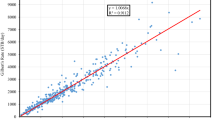Abstract
Pipe section reactor (PSR) is a well-controlled laboratory reactor, which is used to simulate the water quality variations in drinking water distribution systems. However, the hydraulics condition within PSR, which is an essential prerequisite of the water quality studies, still remains unclear. Consequently, the objective of this study is to analyze the hydraulic conditions within PSR by means of a computational fluid dynamics (CFD) approach. The influences of configuration parameters on the hydraulic conditions were tested including propeller diameter, inclined angle of the propeller, distance between the top and inner cylinder, distance between the bottom and inner cylinder, outer cylinder length, baffle length, number of the baffles, rotational speed of the propeller, and inner and outer cylinder diameters. According to the CFD analysis, an optimal structure of PSR was suggested. The data presented here could facilitate the PSR application and improve the simulation of water quality in distribution systems.








Similar content being viewed by others
References
Abokifa, A. A., Yang, Y. J., Lo, C. S., & Biswas, P. (2016). Investigating the role of biofilms in trihalomethane formation in water distribution systems with a multicomponent model. Water Research, 104, 208–219.
Al-Jasser, A. O. (2007). Chlorine decay in drinking-water transmission and distribution systems: pipe service age effect. Water Research, 41(2), 387–396.
Chandy, J., & Angles, M. (2001). Determination of nutrients limiting biofilm formation and the subsequent impact on disinfectant decay. Water Research, 35(11), 2677–2682.
Dietz, J. D., Arevalo, J., & Taylor, J. (2007). Combined chlorine dissipation: pipe material, water quality, and hydraulic effects. Journal - American Water Works Association, 99(10), 96–106.
Digiano, F. A., & Zhang, W. (2005). Pipe section reactor to evaluate chlorine—wall reaction. Journal - American Water Works Association, 97(1), 74–85.
Gomes, I. B., Simões, M., & Simões, L. C. (2014). An overview on the reactors to study drinking water biofilms. Water Research, 62, 63–87.
Gosselin, F., Madeira, L. M., Juhna, T., & Block, J. C. (2013). Drinking water and biofilm disinfection by Fenton-like reaction. Water Research, 47(15), 5631–5638.
Hallam, N. B., West, J. R., Forster, C. F., Powell, J. C., & Spencer, I. (2002). The decay of chlorine associated with the pipe wall in water distribution systems. Water Research, 36(14), 3479–3488.
Hassan, K. Z., Bower, K. C., & Miller, C. M. (2006). Iron oxide enhanced chlorine decay and disinfection by-product formation. Journal of Environmental Engineering, 132(12), 1609–1616.
Hua, P., Vasyukova, E., & Uhl, W. (2015). A variable reaction rate model for chlorine decay in drinking water due to the reaction with dissolved organic matter. Water Research, 75, 109–122.
Kim, H., Kim, S., & Koo, J. (2014). Prediction of chlorine concentration in various hydraulic conditions for a pilot scale water distribution system. Procedia Engineering, 70, 934–942.
Lam, W. H., Hamill, G. A., & Robinson, D. J. (2013). Initial wash profiles from a ship propeller using CFD method. Ocean Engineering, 72(0), 257–266.
Maier, S. H., Powell, R. S., & Woodward, C. A. (2000). Calibration and comparison of chlorine decay models for a test water distribution system. Water Research, 34(8), 2301–2309.
Menaia, J., Coelho, S. T., Lopes, A., Fonte, E., & Palma, J. (2003). Dependency of bulk chlorine decay rates on flow velocity in water distribution networks. Water Science and Technology: Water Supply, 3(1–2), 209–214.
Mi, Z., Zhang, X., & Chen, C. (2016). Iron release in drinking water distribution systems by feeding desalinated seawater: characteristics and control. Desalination and Water Treatment, 57(21), 9728–9735.
Mouly, D., Joulin, E., Rosin, C., Beaudeau, P., Zeghnoun, A., Olszewski-Ortar, A., Munoz, J. F., Welté, B., Joyeux, M., Seux, R., Montiel, A., & Rodriguez, M. J. (2010). Variations in trihalomethane levels in three French water distribution systems and the development of a predictive model. Water Research, 44(18), 5168–5179.
Ndiongue, S., Huck, P., & Slawson, R. (2005). Effects of temperature and biodegradable organic matter on control of biofilms by free chlorine in a model drinking water distribution system. Water Research, 39(6), 953–964.
Ramos, H. M., Loureiro, D., Lopes, A., Fernandes, C., Covas, D., Reis, L. F., & Cunha, M. C. (2010). Evaluation of chlorine decay in drinking water systems for different flow conditions: from theory to practice. Water Resources Management, 24(4), 815–834.
Rossman, L. A. (2006). The effect of advanced treatment on chlorine decay in metallic pipes. Water Research, 40(13), 2493–2502.
Simões, L. C., Simões, M., & Vieira, M. J. (2012). A comparative study of drinking water biofilm monitoring with flow cell and Propella™ bioreactors. Water Science and Technology: Water Supply, 12(3), 334–342.
Vikesland, P. J. (2000). The role of the pipe-water interface in DBP formation and disinfectant loss. Denver: American Water Works Association.
Wert, E. C., Bolding, J., Rexing, D. J., & Zegers, R. E. (2012). Real-time modeling of trihalomethane formation in a full-scale distribution system. Journal of Water Supply: Research and Technology - AQUA, 61(6), 352–363.
Westbrook, A., & Digiano, F. A. (2009). Rate of chloramine decay at pipe surfaces. Journal - American Water Works Association, 101(7), 59–70.
Zhang, H., & Andrews, S. A. (2013). Effects of pipe materials, orthophosphate, and flow conditions on chloramine decay and NDMA formation in modified pipe loops. Journal of Water Supply: Research and Technology - AQUA, 62(2), 107–119.
Zhang, Z., Stout, J. E., Yu, V. L., & Vidic, R. (2008). Effect of pipe corrosion scales on chlorine dioxide consumption in drinking water distribution systems. Water Research, 42(1–2), 129–136.
Author information
Authors and Affiliations
Corresponding author
Rights and permissions
About this article
Cite this article
Hua, P., Ma, S., Ding, W. et al. Structure Analysis of Pipe Section Reactor for Pipe-Wall Reaction: A Computational Fluid Dynamics Analysis Approach. Water Air Soil Pollut 228, 422 (2017). https://doi.org/10.1007/s11270-017-3612-1
Received:
Accepted:
Published:
DOI: https://doi.org/10.1007/s11270-017-3612-1




